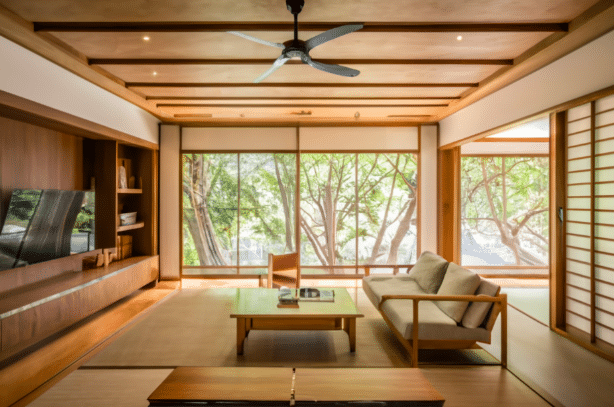The world of design thrives on inspiration, and sometimes the most captivating spaces emerge from unexpected places. Imagine a living room that seamlessly blends the serenity of Japanese minimalism with the vibrant energy of Singaporean design. This Japanese-Singaporean fusion creates a space that celebrates cultural exchange and reflects a unique sense of East-meets-West flair. For design enthusiasts yearning to break away from the mundane, this fusion approach offers a chance to create a truly special living environment.
However, merging design influences that seem so distinct can be a challenge. This article is here to bridge that gap and help you achieve your dream of a harmonious Japanese-Singaporean fusion space. We’ll delve into the core principles of each design style, explore strategies for achieving a balanced and peaceful yet energetic atmosphere, and showcase inspiring examples to spark your creativity.
Embracing the Essence: Core Principles of Japanese and Singaporean Design
Before we dive into the exciting world of fusion, let’s establish a foundation by understanding the core principles that define each design style:
- Japanese Design: Japanese design is deeply rooted in the Zen philosophy, emphasizing minimalism, clean lines, and a strong connection to nature. Natural materials like wood and bamboo are frequently used, creating a sense of calm and tranquility. Functionality is a key principle, with every element in the space serving a purpose.
- Singaporean Design: Singapore, a cultural melting pot, reflects this diversity in its design aesthetic. Bold colors, eclectic patterns, and vibrant textures are hallmarks of Singaporean design. Drawing inspiration from Malay, Chinese, and Indian influences, this style celebrates maximalism and the beauty of cultural fusion.
Finding Balance: Strategies for Harmonious Fusion
Now that we understand the core principles, here’s how to achieve a harmonious Japanese-Singaporean design fusion in your own home:
- Color Palette: Strike a balance between the minimalist color scheme of Japanese design and the vibrant colors favored in Singaporean aesthetics. Japanese design often utilizes natural tones like beige, cream, and brown, creating a calming effect. Incorporate pops of color through accent walls, artwork, or throw pillows to introduce the vibrancy of Singaporean design without overwhelming the space. For example, a minimalist living room with light-colored walls could be enlivened with a vibrant blue accent wall or colorful throw pillows featuring traditional batik patterns.
- Furniture Selection: Combine the clean-lined furniture characteristic of Japanese design with a few statement pieces showcasing Singaporean motifs or bold colors. Imagine a sleek Japanese coffee table paired with accent chairs upholstered in a striking floral fabric. This creates a visually interesting conversation between the two design styles. Remember, the key is to maintain a sense of balance. Don’t overcrowd the space with too many statement pieces, as this can disrupt the tranquil atmosphere of Japanese design.
- Material Mix: Embrace the natural materials favored in Japanese design (wood, bamboo) and complement them with textured materials that reflect Singaporean influences. Woven textiles, patterned rugs, and pops of metal can add depth and visual interest to the space. This creates a harmonious blend that acknowledges both design aesthetics. For example, a living room featuring a wooden coffee table and bamboo side tables could be further enhanced with a woven sisal rug and a decorative metal vase showcasing a vibrant orchid.
- Art and Accessories: Incorporate cross-cultural design elements through your art and accessories. Display minimalist Japanese woodblock prints alongside vibrant Singaporean artwork featuring bold colors and intricate patterns. Scatter decorative objects that reflect both cultures, such as a Japanese ikebana flower arrangement in a sleek ceramic vase or a batik table runner with minimalist geometric patterns. This approach creates a conversation between East and West, adding a layer of cultural richness to your space.
- Lighting: Lighting plays a crucial role in setting the mood and ambience of a space. Japanese design often utilizes natural light and soft, diffused lighting to create a calming atmosphere. Incorporate this approach while also considering the vibrant energy of Singaporean design. Strategically placed lamps with colorful shades or textured lampbases can add pops of color and visual interest without compromising the overall tranquility of the space. Dimmer switches allow you to adjust the lighting based on the mood and activity, further enhancing the space’s versatility.
Inspiration Gallery: Showcasing Successful Fusion
To truly visualize the potential of Japanese-Singaporean design fusion, let’s explore some inspiring examples:
- Image Gallery: Curate a collection of high-quality images showcasing successful East-meets-West interiors. Include examples that demonstrate the balanced use of color palettes, furniture selection, material mix, art curation, and lighting techniques discussed in the previous sections. Focus on showcasing spaces that achieve a sense of harmony and visual appeal while reflecting the distinct characteristics of both Japanese and Singaporean design.
Here are some specific examples of images you could include in your gallery:
- A minimalist living room with light-colored walls, a sleek wooden coffee table, and a vibrant blue accent wall adorned with Japanese woodblock prints.
- A dining room featuring a clean-lined wooden dining table paired with colorful chairs upholstered in batik fabric. A woven sisal rug adds texture, and a minimalist ceramic vase filled with vibrant orchids serves as a centerpiece.
- A bedroom that combines a minimalist platform bed with a bold floral patterned headboard. Natural light streams through the window, and a woven wall hanging featuring geometric patterns adds a touch of Singaporean flair.
By including a variety of inspiring examples, you can provide readers with a clear understanding of how to achieve a successful Japanese-Singaporean design fusion in their own homes.
Conclusion: A Celebration of Cultural Fusion
Japanese-Singaporean design fusion offers a unique opportunity to create a living space that celebrates the beauty of cultural exchange. By embracing the core principles of each style, implementing the fusion strategies outlined above, and drawing inspiration from successful examples, you can achieve a harmonious and visually captivating space that reflects your personal taste and appreciation for both Eastern and Western aesthetics. So, unleash your creativity, embrace the spirit of fusion, and embark on a journey of creating a truly unique and inspiring living environment.
To achieve harmony in diversity by fusing Japanese and Singaporean design, partner with MRD. Transform your living spaces into a unique and beautiful blend of cultures by working with MRD today. Let their expertise in creating visually appealing and functional environments bring your vision to life, creating a home that promotes relaxation and rejuvenation. Take the first step towards a more culturally rich and aesthetically pleasing living space – contact MRD now and experience the difference their innovative designs can make in your daily life!



